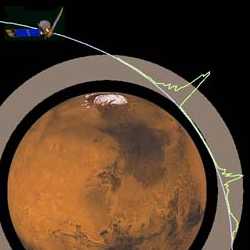 |
This image is a blow-up of the previous
one showing the part of the orbit closest to the planet. This illustrates
one way in which the magnetometer and electron reflectometer work together
to study the planet. Unlike the Earth's ionosphere, the Martian ionosphere
is not shielded from the solar wind by a strong planetary magnetic field.
The solar wind rams into Mars' ionosphere and generates complicated magnetic
fields (wavy lines) that can obscure any magnetic anomalies in the crust.
Orbits that dip beneath the ionosphere are highly valuable because they
take us closer to the crustal magnetic fields that we wish to measure and
farther from ionospheric magnetic fields. The electron reflectometer helps
the magnetometer by signaling when the spacecraft is beneath the ionosphere.
The goal of aerobraking is to reach a circular orbit 235 miles above
the surface. This is shown by the dashed line. On the day side of the planet,
the spacecraft would fly within the ionosphere, where it can be a difficult
task to measure crustal magnetic anomalies. Our best chance of detecting
crustal magnetic anomalies in such an orbit will be on the planet's night
side, where the ionosphere is much weaker or absent. During this phase
of the mission, the electron reflectometer will look for electrons reflected
from magnetic anomalies on the surface. These reflected electrons tell
us how much stronger the surface field is compared with the field measured
at the spacecraft by the magnetometer. This technique allows us to continue
studying crustal anomalies at higher altitudes.
|
